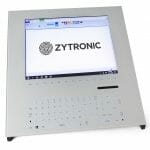Applying new technology to a physical process or manufacturing system is an essential part of progress, however the practical side of implementing the latest Industrial Internet of Things (IIoT) and Smart Technology solutions is bringing its own unique challenges. That in turn is leading to new automation solutions.Chris Evans – Marketing and Operations Group Manager of Mitsubishi Electric UK looks at the latest challenges and solutions.
When looking to develop and install new smart manufacturing systems at an existing location one of the most important pieces of groundwork that needs to be carried out is to fully understand what the organisation is trying to achieve and what are their immediate “pinch points?” In addition for an existing location, what is the level of automation and infrastructure that already exists and what needs to be added in order to create a bridge between the operational technology (OT) and the information technology (IT) levels in the organisation. This vertical integration of a factory or plant has machines with automation on one side and the enterprise level on the other and it is the ability to gather information and bridge this OT/IT gap which will ultimately create the opportunity to become a smart manufacturing operation.
As already mentioned, to enable IT and OT integration there must also be horizontal connectivity at the shop floor level, i.e. between machines from different suppliers with disparate automation vendor’s equipment and different elements of plant control. Therefore, the openness of the automation technologies being used plays a key role; communication standards need to be used that will “speak” to all machines, sensors, actuators and other components. Evaluating the current level of automation and network infrastructure is critical in understanding what will be possible in the short, medium and long term and how easy or difficult it will be to match the goals of the organisation in becoming a smart operation. The good news is that whatever level an organisation is currently at, with good project planning and communication the journey towards digitalisation and smart manufacturing can be achieved to the appropriate level for the organisation in question.
Adoption of standards for machine control and network connectivity has further aided the process, for example in the food & beverage and packaging industry, organisations are frequently operating in a multi-vendor automation machine environment and are now using developments in the OMAC PackML and OPC UA standards to achieve better integration.
Talking heads
In the past the IT and OT worlds have not been natural bed fellows with the OT world operating in real time with process speeds of milliseconds or below and the IT world operating at much longer sampling times, such minutes, hours or more. There has been a natural divide between these two worlds but the advent of Edge computing technology to sit in the “space” between the two has made the integration of these seemingly diverse worlds much more straight forward and allowed a greater level of choice about where data analysis takes place.
It is easy to assume that if the necessary levels of automation and network infrastructure on plant either already exists or now exists as phase one of our implementation plan to become smart, the natural extension of this is to just collect every byte of data that it is possible to collect and sit back and admire what has been achieved.
Of course it needs to be more scientific than that. Inevitably, increased communication in recording those machine ‘conversations’ will create the need to manage a far higher volume of data. This requires the creation of a platform for efficient data analytics and data transfer between the OT and IT levels. The challenge is to handle all that data in a structured way, filtering out unnecessary “noise” and turning “Data” into “Information”.
Not losing sight of our goal to become a smart manufacturing plant, performing analysis on this data will provide the ability to visualise all the important aspects of production: OEE (Overall Equipment Effectiveness), productivity, quality control, use of raw materials, waste and predictive and preventative maintenance, all of which are very familiar to production directors tasked with making the operation more efficient. The question is often “where best to implement our data analytics?” Is it best to move everything to enterprise level servers or even the cloud, or is there an alternative?
Of course the new smart technology appearing at the “Edge” not only gives an alternative but greater flexibility and efficiency of data management. Edge computing offers industrialised solutions designed to live in the plant environment like all other automation equipment and to be at the “sharp end” of the data collection process. As previously discussed, the IT and OT worlds are often divided by the frequency at which data is sampled but Edge solutions offer the chance to perform sophisticated data analysis incorporating recognised AI algorithms in real time and therefore interface with the plant automation systems at high speed, making machine learning and improved production efficiencies a reality.
The next major benefit to carrying out data analytics at the Edge layer, is that the data can be filtered and only the necessary and relevant data passed to the enterprise or cloud based servers. This can considerably reduce the cost of data processing at this level, where cost is often attributed to the number of data points processed. It is clear that by linking the IT and OT world, the Edge classification of technology is playing a key role.
Into this space, Mitsubishi Electric has launched the MELIPC Edge-Computing solution.: The MELIPC solution takes care of all connectivity issues “downstream” to the plant level, supporting all of the major open networks and removing the problem of interfacing to machines or plant assets controlled by disparate automation vendors. It provides a real time data logging and processing environment in a ruggedized industrial form factor. From a data processing perspective, it incorporates a suite of analytical tools such as; multiple regression analysis, the Mahalanobis-Taguchi system and Statistical Process Control (SPC) and AI functionality such as Similar Waveform Recognition, giving responses to process analysis in real time.
MELIPC has a dual operating system of Windows and VxWorks RTOS which gives the user the flexibility of embedding third party applications into either of these environments. The VxWorks RTOS environment has a proven track record of running critical embedded applications where high availability is a mandatory requirement. The internal structure of MELIPC follows the Edgecross framework as defined by the Edgecross Consortium which is an independent organisation of over 200 members whose goal put simply is to standardise the interface between the OT and IT layers.
In the final analysis
One of the biggest challenges faced by manufacturing industry is to ensure that final product quality remains consistent, independently of variable environmental conditions, raw products and in-feed ingredients.
Many plants have “optimised” their operations but what digitalisation and the road to smart manufacturing offers in addition to this, is the ability to move to a predictive model based on a continuous improvement strategy and if this is followed to its ultimate conclusion then the whole plant eco system including energy supply and the supply of raw materials can be completely integrated and made operationally efficient. The seamless vertical connectivity between OT and IT also opens up manufacturing industry to newer business models – like ‘batch size one’ or the rapid changeover of one product line to another to keep pace with fast moving consumer trends.
One of the key takeaways from this march of change, in systems, technology and networking is that it can be applied equally to existing production lines and equipment as it can for new factories. Manufacturing by its nature is now a mature industry, so upgrades and progress inevitably involve managing change, not just for physical plant and software layers but for people too.
All manufacturing plants have the capability to become smart operations, the journey to that goal may be short or long but can be achieved step by step with the right planning, required investment and partnering with the right automation vendor to help plot and navigate the course.








